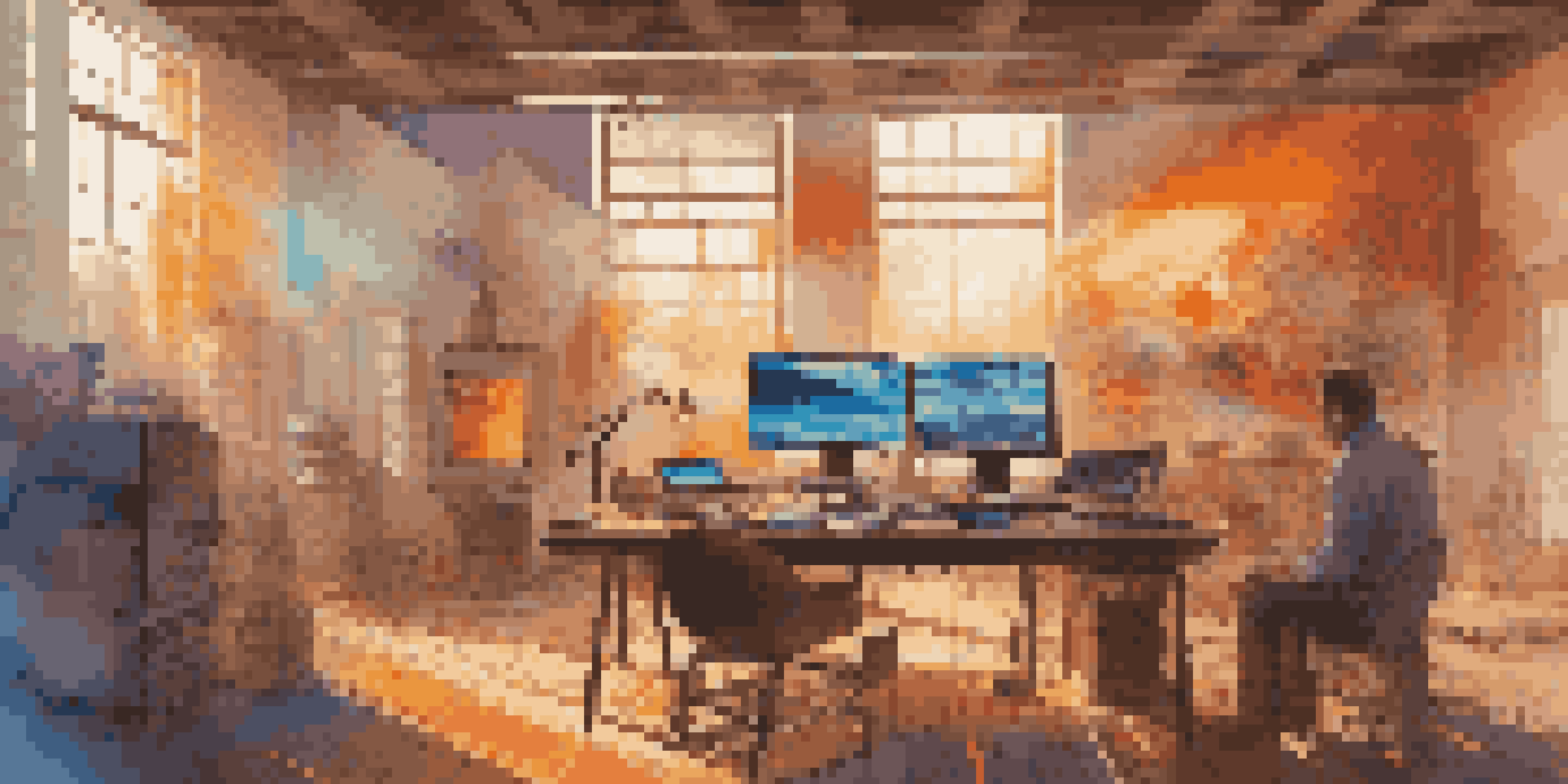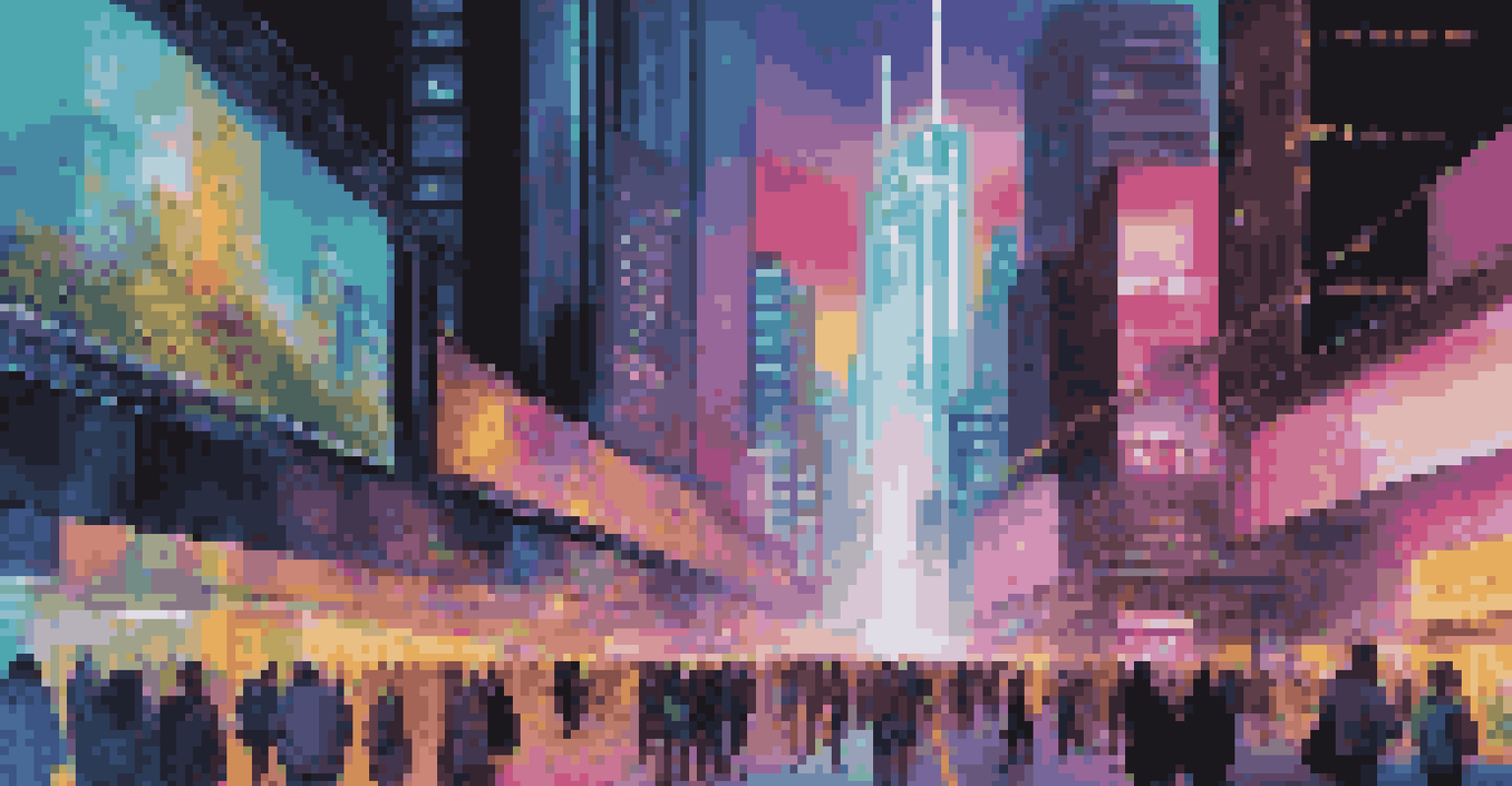Art and Algorithms: The Role of Data in Creative Processes

The Intersection of Art and Technology
In today's digital age, art and technology have become increasingly intertwined. Artists are now exploring the capabilities that algorithms and data offer, blurring the lines between traditional art forms and digital creations. This fusion allows for innovative expressions that challenge the conventional definitions of art.
Art is not a mirror held up to reality, but a hammer with which to shape it.
For example, generative art uses algorithms to create unique pieces that evolve over time, reflecting the artist's vision while also being influenced by data inputs. Artists like Casey Reas and Rafael Lozano-Hemmer have embraced this approach, showcasing how technology can enhance creativity rather than replace it. This intersection invites audiences to reconsider what art can be.
Moreover, as technology continues to advance, we can expect even more collaboration between artists and data scientists. This partnership not only expands the creative toolkit available to artists but also democratizes access to artistic creation, allowing anyone with an idea and a computer to participate.
Understanding Data-Driven Creativity
Data-driven creativity refers to using data as a foundational element in the artistic process. This can range from analyzing audience preferences to utilizing real-time data streams to influence a piece's evolution. Artists are increasingly leveraging data to make informed decisions that resonate with their audiences, leading to more relatable and meaningful works.

A prime example is the use of social media data by contemporary artists to gauge public sentiment and influence their creations. By examining trends and interactions, artists can create works that reflect societal moods, thus fostering a deeper connection with viewers. This not only validates the artist's work but also encourages dialogue around important issues.
Art and Tech: A Creative Fusion
The convergence of art and technology enables innovative expressions that redefine traditional art forms.
Additionally, data can inspire new themes and narratives in art, leading to unexpected outcomes. When artists tap into vast amounts of information, they can uncover hidden patterns that spark creativity and offer fresh perspectives.
The Role of Algorithms in Artistic Creation
Algorithms are at the heart of many modern artistic processes, serving as tools that enable artists to explore new realms of creativity. By setting parameters within which their algorithms operate, artists can create works that are both unique and unpredictable. This element of surprise adds an exciting dimension to the artistic experience.
The computer is a powerful tool for artists, allowing them to create new forms and experiences that were previously unimaginable.
For instance, the use of algorithms in music composition allows for the generation of melodies that might not be conceived through traditional methods. Artists like AIVA and Amper Music use AI-driven algorithms to compose original scores, blending human creativity with machine efficiency. This collaboration can lead to innovative soundscapes that push the boundaries of musical genres.
Moreover, the algorithms can learn from previous data, adapting and evolving over time. This means that the artistic process can be dynamic, continually growing and shifting based on both the artist's input and the data's influence, creating a living piece of art.
Case Studies in Algorithmic Art
Several artists and projects exemplify the successful integration of algorithms in art. One notable example is the work of Refik Anadol, whose installations use data from various sources to create immersive visual experiences. His pieces transform information into stunning visual art, inviting viewers to engage with the data in a new way.
Another case study is the 'Obvious' collective, known for their AI-generated artwork, particularly the portrait 'Edmond de Belamy'. This piece, created using machine learning algorithms, sparked conversations about authorship and the role of the artist in the digital age. It highlights how algorithms can produce art that resonates with audiences and raises ethical questions.
Data Drives Artistic Decisions
Artists increasingly use data to inform their creations, fostering deeper connections with audiences.
These case studies illustrate that algorithmic art isn't just a trend; it's a movement that challenges our understanding of creativity. By examining the outcomes of these projects, we can see the potential for continued exploration at the intersection of art and technology.
The Ethical Considerations of Data in Art
As we embrace the integration of data in creative processes, ethical considerations become paramount. Issues such as data privacy and the ownership of generated art raise important questions that artists and technologists must navigate. Transparency in how data is sourced and used is crucial in maintaining trust with audiences.
For instance, when artists use personal data from social media, consent and anonymity become significant concerns. Artists need to be mindful of the implications their work may have on individuals' privacy and the potential for exploitation. Open dialogues about these concerns can help establish ethical guidelines for the future.
Moreover, artists and technologists should collaborate to create frameworks that prioritize ethical practices. By doing so, the art world can continue to innovate while respecting the rights and dignity of individuals whose data informs the creative process.
Future Trends in Art and Algorithms
Looking ahead, the relationship between art and algorithms is poised for further evolution. As technology advances, we can expect new tools and platforms that enhance artistic expression. Virtual reality (VR) and augmented reality (AR) are just the beginning of what’s possible, allowing for immersive experiences that engage the audience in unprecedented ways.
Additionally, the growing field of machine learning will likely lead to enhanced collaboration between artists and algorithms. Artists may increasingly rely on AI to assist in their creative process, blurring the lines between creator and creation. This trend opens up exciting possibilities for interactive art, where viewer participation shapes the final outcome.
Ethics in Algorithmic Art
Navigating data privacy and ownership is essential as artists integrate algorithms into their creative processes.
Ultimately, the future of art and algorithms will be defined by a balance of innovation and ethical responsibility. As artists continue to explore the vast potential of data, they must remain grounded in the values that prioritize human experience and connection.
Conclusion: Embracing the New Artistic Landscape
The integration of art and algorithms presents an exciting frontier for creativity. By embracing data-driven approaches, artists can expand their horizons and explore new narratives that resonate with contemporary audiences. This evolving landscape encourages experimentation, collaboration, and innovation in ways previously unimaginable.
As we move forward, it’s essential for artists, technologists, and audiences alike to engage in conversations about the implications of this fusion. By understanding the role of data in creative processes, we can appreciate the unique contributions it brings while addressing the challenges that arise.

In conclusion, art and algorithms together create a dynamic interplay that reflects our modern world. As we continue to navigate this space, let’s celebrate the creativity that emerges from the collaboration between human imagination and technological advancement.